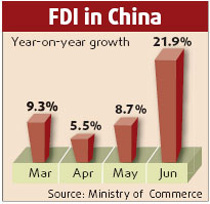The recent record high of global wheat prices has nothing to do with China, a senior researcher with the State Administration of Grain (SGA) said yesterday.
"China is not a precipitator of the mounting increase in global wheat prices, but an important stabilizing factor for it," Ding Shengjun said in Beijing.
The country's supply and demand of wheat is "basically balanced" because of a four-year consecutive increase in total grain output between 2004 and last year, Ding said.
"The trend in China - year-on-year grain output increases, a balanced supply-demand market, improved reserves and mild, structural grain price increases - is in sharp contrast with the global downturn in grain output and reserves," he said.
International markets have recently been struck with unprecedented price hikes in major crops.
The Economist's food price index is at its highest level since it was launched in 1845. The Food and Agriculture Organization (FAO) of the United Nations has also warned of potential food shortages for the first time since 1970, attributing the soaring prices to the ongoing drive to use food crops to produce biofuels.
The FAO's global food price index rose 40 percent last year compared with 9 percent in 2006. Skyrocketing food prices have become major concerns in many countries, where food accounts for 10-70 percent of the consumer price index.
In the United States, the world's largest exporter of wheat, stocks for the 2007/2008 crop year were predicted to fall to a 60-year-low. But growth in food demand has continued, particularly in Asia.
China's grain reserves now compose more than 35 percent of the annual national output of grain consumption. With the exception of soybeans, the country has become a major crop exporter, with 2.85 million tons of crops exported in 2006 and 7.7 million tons between last January and November.
"This ... means that recent foreign reports about China's increasing role in furthering the global food crisis are totally against reality," Ding said, adding that the major use of China's crop imports is to diversify its domestic food supply.
Ding admitted that due to the boost in soybean and soybean oil consumption a demand-supply gap does exist and there is a need for soybean imports.
Bloomberg reported on Friday that soybean and soybean oil futures in Chicago soared to a record high on speculative demand from China and will climb after blizzards damaged the nation's rapeseed crop.
China is the world's largest importer of soybeans and vegetable oil. Almost half the autumn and winter rapeseed crop was affected by rain and snow, the China National Grain & Oils Information Center said last week. Rapeseed, like soybeans, is crushed into meal for livestock feed and cooking oil.
"However, the vast majority of supplies we import are used for joint ventures producing vegetable oil, part of whose products end up in international markets," Ding said.
(China Daily February 19, 2008)


